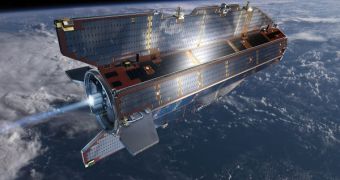Since the European Space Agency (ESA) launched its Earth Explorer program, no results have been obtained. Now that the Gravity Field and Steady-State Ocean Circulation Explorer (GOCE) satellite has finally begun its measurements, the first information will start being circulated. The observatory is designed specifically to record tiny variations in our planet's gravitational tug, and it is scheduled to create the first complete map detailing these changes to date. According to its schedule, GOCE will begin its scientific observations this week, after a period of adjustments and calibrations.
Launched from the Plesetsk Cosmodrome in north-western Russia this March, the satellite is able to detect and record gravity-field anomalies with an accuracy of 1 part in 10,000,000,000,000. In order to benefit from an increased level of accuracy, and a higher resolution, the craft flies in an unusually low orbit, just 255 kilometers above the Earth's surface. GOCE will also hopefully be able to construct the geoid with an accuracy of one to two centimeters. The geoid is the true physical figure of the Earth, and does not correspond to the actual surface of the planet.
“We've been in the so-called eclipse mode where the Sun doesn't shine fully on the solar panels, but now we are entering the measurement mode. Being able to fly low is very good for the measurements, and the Sun is so low in its activity at the moment that we can fly lower than we expected; and that will give us a better signal,” the Director of the ESA Earth Observation, Dr. Volker Liebig, told the BBC News. Engineers have finished their tests and adjustments for some time now, and have given the observatory a clean bill of health.
“We've been trying to discover just how good our measurements are. We've taken our measurements and we've compared them with the state-of-the-art models of the Earth's gravity field that are available today. And what we see is what we hoped to see: our measurements basically follow the trend but certainly do contain a lot more high-frequency, finer-scale information,” the ESA GOCE Mission Manager, Dr. Rune Floberghagen, added. The expert explained that the Earth's gravitational pull was not the same all over its surface, but differed by slight amounts. It's GOCE's job to map these anomalies.

 14 DAY TRIAL //
14 DAY TRIAL //